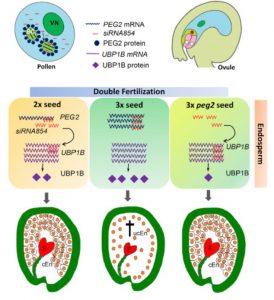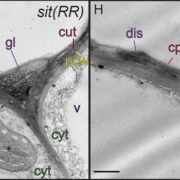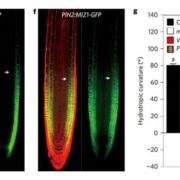The imprinted gene PEG2 acts as a sponge for the transposon-derived siRNA854, inducing postzygotic reproductive isolation (Devel. Cell)
 Closely related species that have different numbers of chromosomes (e.g., 2n versus 4n) are reproductively isolated, and this can arise as a consequence of an unbalancing in the expression levels of maternally- and paternally-imprinted genes. Wang et al. have identified a fascinating mechanism that explains why the seeds of different-ploidy hybrids frequently abort. The authors found that PEG2 (Paternally Expressed Gene 2) transcripts act as small RNA sponges for siRNA854, which is present in the vegetative cell of the pollen due to epigenetic reprogramming. One of the natural targets of siRNA854 is UBP1b, which encodes an RNA-binding protein that sequesters transcripts in stress granules. In triploid seeds (formed from diploid / tetraploid hybridization), excess production of PEG2 transcripts sponges up all of the siRNA854, leading to excess production of UBP1b and seed abortion. Thus, a sensitive gene-dosage check that contributes to the “triploid block” has been identified. (Summary by Mary Williams) Dev. Cell 10.1016/j.devcel.2018.07.014
Closely related species that have different numbers of chromosomes (e.g., 2n versus 4n) are reproductively isolated, and this can arise as a consequence of an unbalancing in the expression levels of maternally- and paternally-imprinted genes. Wang et al. have identified a fascinating mechanism that explains why the seeds of different-ploidy hybrids frequently abort. The authors found that PEG2 (Paternally Expressed Gene 2) transcripts act as small RNA sponges for siRNA854, which is present in the vegetative cell of the pollen due to epigenetic reprogramming. One of the natural targets of siRNA854 is UBP1b, which encodes an RNA-binding protein that sequesters transcripts in stress granules. In triploid seeds (formed from diploid / tetraploid hybridization), excess production of PEG2 transcripts sponges up all of the siRNA854, leading to excess production of UBP1b and seed abortion. Thus, a sensitive gene-dosage check that contributes to the “triploid block” has been identified. (Summary by Mary Williams) Dev. Cell 10.1016/j.devcel.2018.07.014









